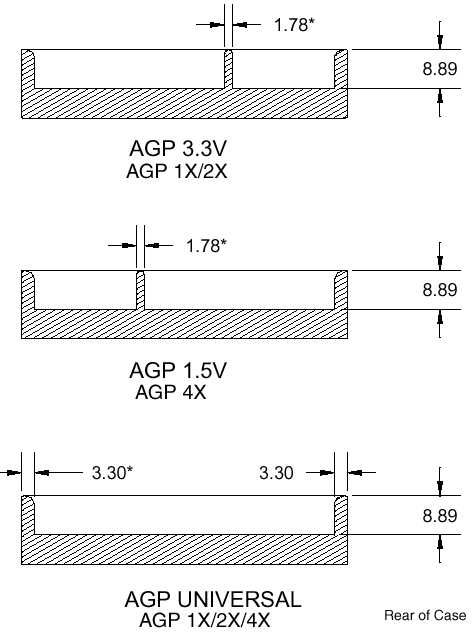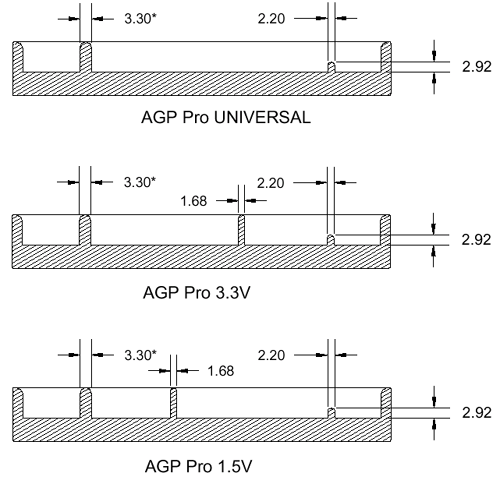i820 Motherboard Roundup - January 2000
by Anand Lal Shimpi on January 28, 2000 2:44 AM EST- Posted in
- Motherboards
A newcomer to the expansion slot field is the AGP Pro slot. The AGP Pro specification is an extension of the AGP 4X specification that features a connector with 48 more power and ground pins, 20 of them on one end of the regular AGP 4X connector and the remaining 28 pins on the other end. The transfer rate over an AGP Pro slot is identical to that of an AGP 4X slot (1.06GB/s), and thus doesn’t operate at any higher frequency.
The purpose of the AGP Pro slot is to power the demanding AGP cards that are slowly but surely appearing in the high end market. These cards, known as AGP Pro50 or AGP Pro110 cards, require more power than the standard AGP slot can provide and thus benefit from the extra power pins provided for by the AGP Pro slot.
An AGP Pro50 card consumes 25W – 50W of power (hence the name Pro50) and an AGP Pro110 card consumes anywhere from 50W of power up to a full 110W (again, hence the name Pro110). A regular AGP card can be used in an AGP Pro slot, but because of the extra power required and the 48 new pins, an AGP Pro card cannot be used in a regular AGP slot.
According to the current revision of the AGP Pro specification (1.1A), retail AGP Pro110 cards can use up to 2 adjacent PCI slots as clearance for cooling the card. The AGP Pro50 specification calls for only 1 PCI slot to be left unoccupied for this purpose. In order to ensure that these slots remain free, a three-slot (AGP Pro110) or a two-slot wide I/O bracket can be installed.
According to the specification, this is simply an option and OEMs may choose not to use an I/O bracket to free up those slots. If the AGP Pro card is a multi-slot solution then the specification states that those additional slots can be used for mechanical support, electrical power, or PCI bus function purposes. We have yet to see a design that implements such a unique multi-slot solution, but the specification does allow for it, should the need arise.
AGP Connectors
- Taken from AGP Pro Specification 1.1A


The first AGP Pro card that we saw was the reference DDR Quadro board from NVIDIA. From our review of the DDR Quadro, you’ll know that the board was a 64MB reference board equipped with Double Data Rate SGRAM, which in itself consumes quite a bit of power, but when coupled with the 23 million transistor Quadro chip placed on the board, the card turns into quite a bit of a power hog. While we ran the DDR Quadro board through our professional level tests without any problems on a regular AGP slot, expect more and more high end cards to begin to require the added power the AGP Pro slot is capable of delivering.
In order to make the point that the demand for more power to AGP cards is a valid one, take a look at the next generation of 3dfx graphics accelerators. The Voodoo5 6000 requires an external 100W power supply in order for it to run properly. This is virtually the maximum amount of power the AGP Pro110 specification states can be delivered to a card, and it’s not even for a professional level graphics accelerator.
Out of the seven i820 motherboards we have been testing for the past few weeks, two of them are outfitted with AGP Pro slots. Depending on what your system is going to be used for, an AGP Pro slot may be something you’re interested in having. Whether or not manufacturers adopt the AGP Pro standard and use it in their card designs has yet to be seen, but the fact of the matter is that graphics cards are drawing more and more power (i.e. Voodoo5 6000) and, in order to supply the necessary power to these cards, the motherboards will either have to sport AGP Pro slots or video card manufacturers will have to move to 3dfx’s solution of providing an external power supply.










1 Comments
View All Comments
renterpoint - Wednesday, April 13, 2022 - link
This is a very nice motherboard. Thank you for posting such a nice piece of information.https://renterpoint.com/suv